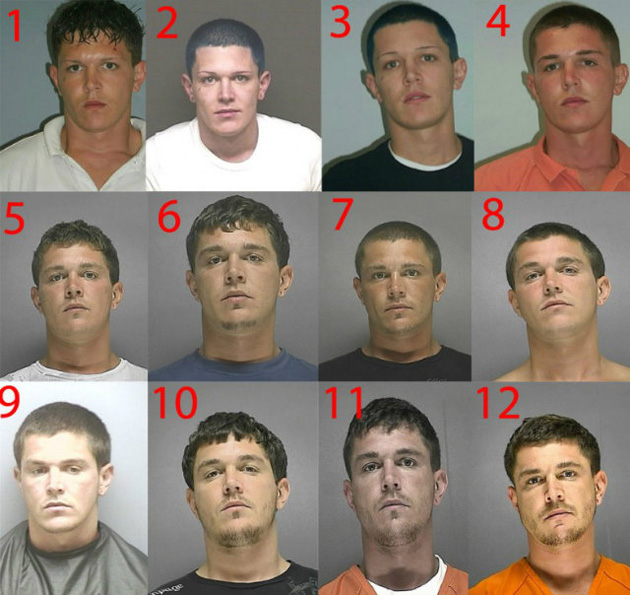Found a few more Blue Collar Studs :dick:
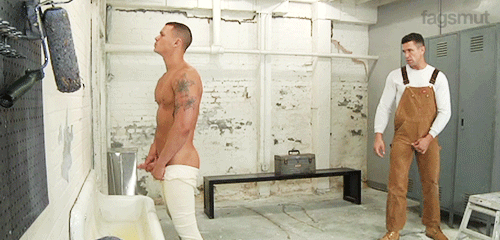
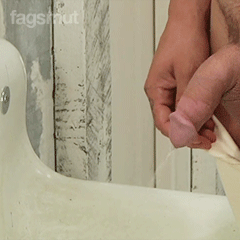
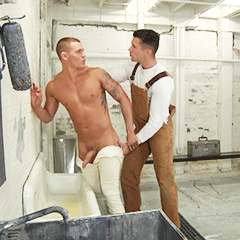
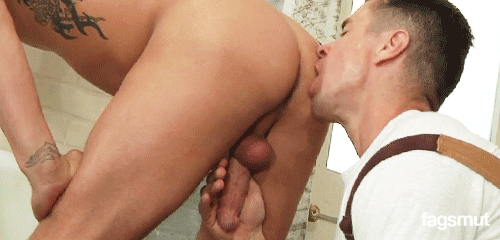
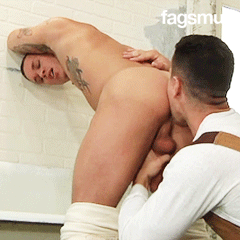

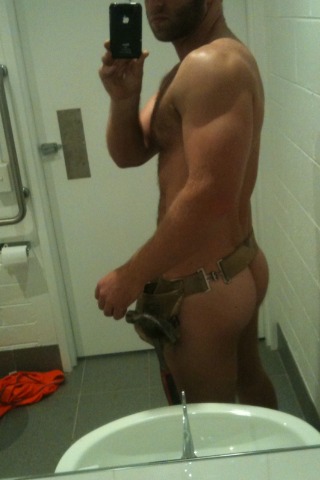
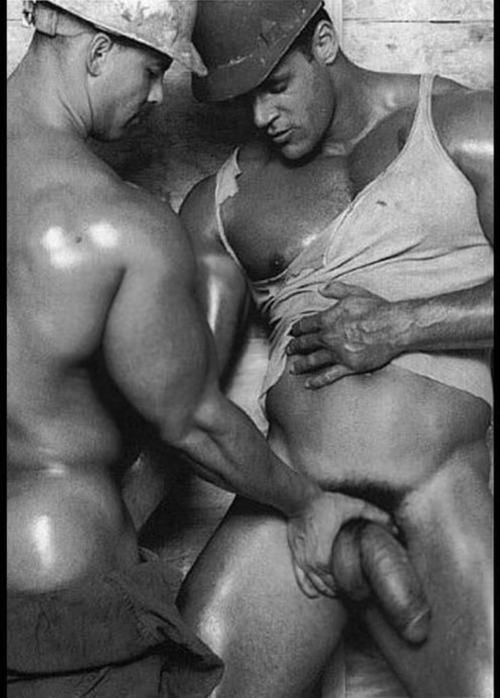
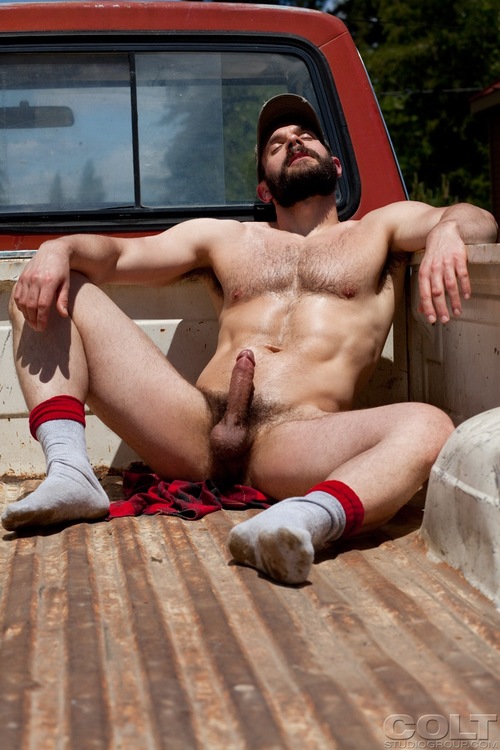
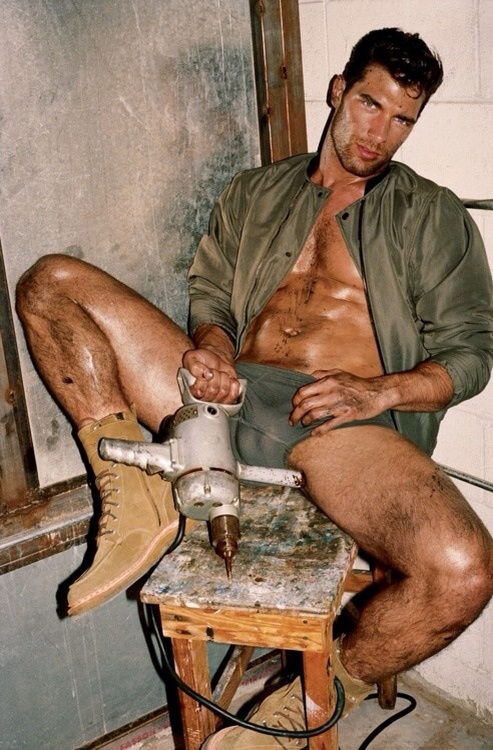
:hehe: Look at the bottom right corner :hehe:
Taken from a post made elsewhere by cannonmc
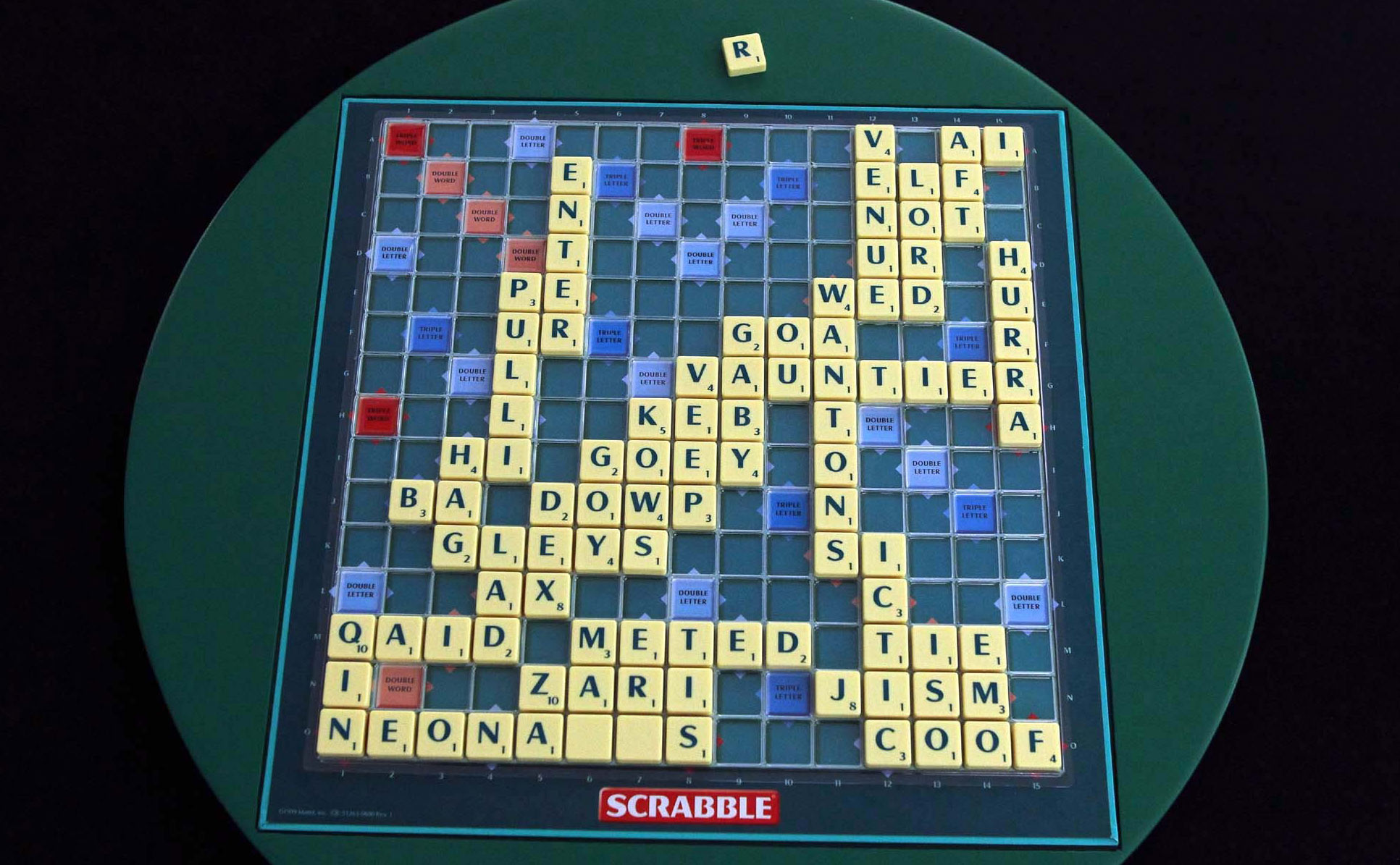
Wooooffff!!!
That is a sight I am used to but surprised bluehue finds it interesting :faint:
:drool2: A formidable toy indeed ~ looks like it could be fun to use on someone to expand their boundaries >:D
Catholic Leader, Named Bigot Of The Year
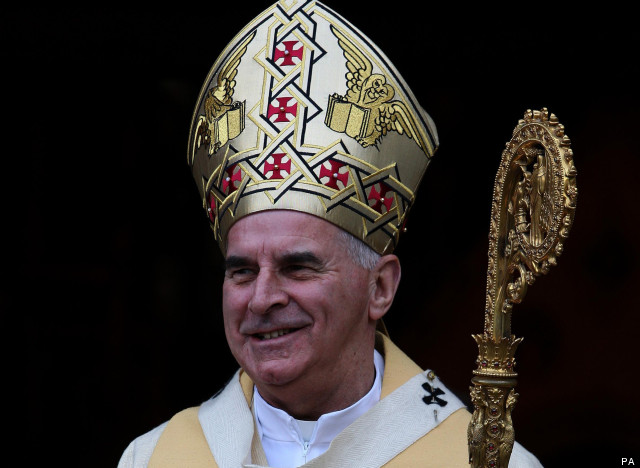
Cardinal Keith O'Brien, the leader of the Catholic Church in Scotland was given the 'bigot of the year' award
A row has broken out after Cardinal Keith O'Brien, leader of the Catholic Church in Scotland, was named "bigot of the year" by gay rights charity Stonewall.
The award has now been labelled "an outrage" and showing "significant lack of judgement" by the church.
Scottish Conservative leader Ruth Davidson, who picked up a politician of the year gong at the ceremony, used her speech to condemn the "bigot" category, saying campaigns for equality were better served in other ways, but she was booed off the stage.
The Scottish Cardinal was voted for by 10,000 supporters and came after the cardinal went "well beyond what any normal person would call a decent level of public discourse" during the heated debate over gay marriage in Scotland.
O'Brien called off talks with the Scottish government over same-sex marriage earlier this year after comparing the reform to the re-introduction of slavery, describing it a "grotesque subversion of a universally accepted human right."
He has also compared gay marriage with paedophila, saying: "What if a man likes little girls? Can he adopt a little girl and then just have a little girl at home? We are working towards the destruction of any sort of moral standards."
Gay Marriage is be made legal in Scotland, the SNP government announced earlier this year.
The rest of the story found here:
hXXp://www.huffingtonpost.co.uk/2012/11/02/stonewall-bigot-keith-o-brien_n_2063015.html?utm_hp_ref=gay-voices&ir=Gay%20Voices
An Interview with 'No Straight Lines' Editor Justin Hall
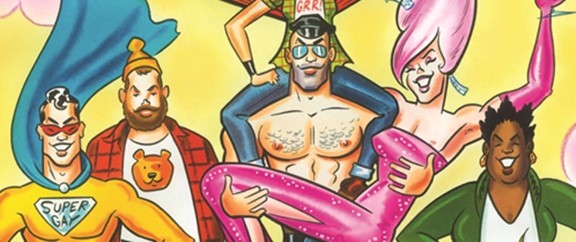
Nov 1st 2012 By: Andrew Wheeler
Earlier this year Fantagraphics published an extraordinary collection of LGBT comics from the past four decades. No Straight Lines brings together comics from the early days of the alternative and underground press, stories from the era of the AIDS crisis, contemporary webcomics dealing with identity and gender issues and much more in one volume. The result is a fascinating examination of post-Stonewall queer culture.
To mark the end of Queer History Month, ComicsAlliance spoke to No Straight Lines editor Justin Hall, a cartoonist whose personal works include True Travel Tales and Glamazonia, to learn what inspired the collection, how he put it together, and what he thinks readers and cartoonists alike can learn from it.
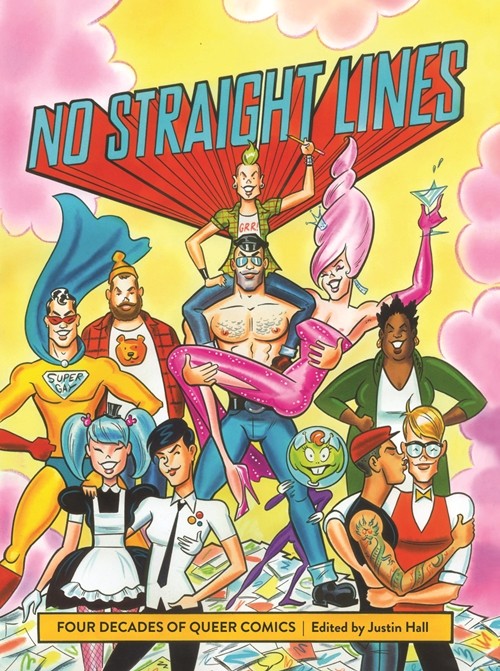
Comics Alliance: First, Justin, congratulations on putting the book put together. It's a beautiful work from beginning to end.
Justin Hall: Thank you. I really wanted a kind of coffee table book. Obviously it has historical importance and cultural importance but I also wanted something that is a beautiful art object. Increasingly as comics go online the stuff that remains in print has to have kind of a fetishy quality to justify its presence on the bookshelves and to justify all the dead trees.
CA: How did the project come about?
I curated a show at the San Francisco Cartoon Art Museum called No Straight Lines: Queer Culture and the Comics, and that was the world's first museum show of this material, so the Cartoon Art Museum has been an amazing supporter of this project through every step of the process and I can't thank them highly enough.
We wanted to do a catalog of the show, but the funding fell through for it, so that was the genesis of the project. It stuck in my head that a book needed to be done along these lines, and of course, as these ideas do, they sort of grow in your head and become this monster, and several years later it was time to pitch this thing and I went to Fantagraphics.
CA: Tell me about your philosophy as the curator of this collection. Was there a picture you wanted to paint, or certain boxes you think you needed to tick?
I thought of it as a sort of three-tiered editorial approach. My first category was artistic worth. Absolutely every story in this book needed to be good comics. I wanted people to open this book, even people who don't know much about comics, and be able to enjoy it thoroughly.
The second thing was historical relevancy. The book is divided into three general chronological sections, so the book spans four decades of this material. The first section focuses on the gag strips coming from the early gay newspapers and gay magazines that exploded after the Stonewall Riots, and also the underground commix that were feminist oriented and eventually queer oriented that came out of the underground commix movement beginning in San Francisco. This covers roughly the time between the late 1960s and through the 70s.
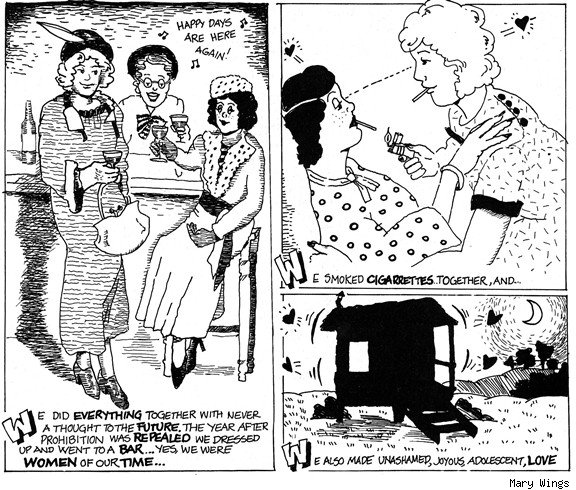
Child Labor, by Mary Wings
The second section focuses on the 80s and 90s as AIDS hit, so there are a lot of cartoonists' reactions to HIV and the AIDS epidemic. Then there were the punk zines that came about in the 90s that really changed the dynamic of queer comics and alternative comics in general.
The final section focuses on a new batch of trans and non-binary gendered creators, which is really I think the most exciting segment of queer comics right now. There's incredible work being done on genderqueer themes. The third section also deals with the movement on to the web and out of the traditional queer media ghetto of the gay publishers, gay newspapers, and gay bookstores.
The final editorial approach would be representational merit. I wanted to make sure there was obviously a good balance between women and men, make sure there were enough trans voices, also comics from different points of view, comics about different subjects. Everything from the AIDS crisis to doing drag, to marriage, immigration, bullying, domestic abuse, to dealing with racism in the gay community, to coming out stories.
CA: Were most of the comics in the collection ones that you had come across over time, or did you have to do a lot of hunting to put the book and the art show together?
When I curated the show, that was 2006, and Andrew Farago of the Cartoon Art Museum worked with me on it and I think it was a very important show, but I learned a lot more about queer comics in the years following that. I became the talent relations chair for Prism Comics, which is an advocacy group for LGBT comics, so that enabled me to learn more about the history of queer comics and also to start looking at a lot of the emerging web comics and new developments in queer comics, so the book is much much more extensive than the show was able to be.
We also do a Queer Press Grant every year at Prism Comics, where we give an annual award to self-publish an independent comic supporting queer characters and queer themes, and every year the applicants get better, they get more diverse. It's inspiring what's happening, what's continuing to happen with this talent pool.
CA: I came of age in the 90s, and I expected the comics from the 70s and 80s to feel like a time capsule of a previous generation's gay culture and gay attitudes, but I was surprised that I found it very resonant and very relevant, and I recognized the culture and the attitudes today. Did you have that experience?
It's very interesting you bring that up because that's something that caught me off guard as well. The narrative in my own head was that the first section of the book, comics from the 70s, would feel really dated, and that would be of historical merit but it would look kind of silly compared to how sophisticated we've gotten about queer identities now.
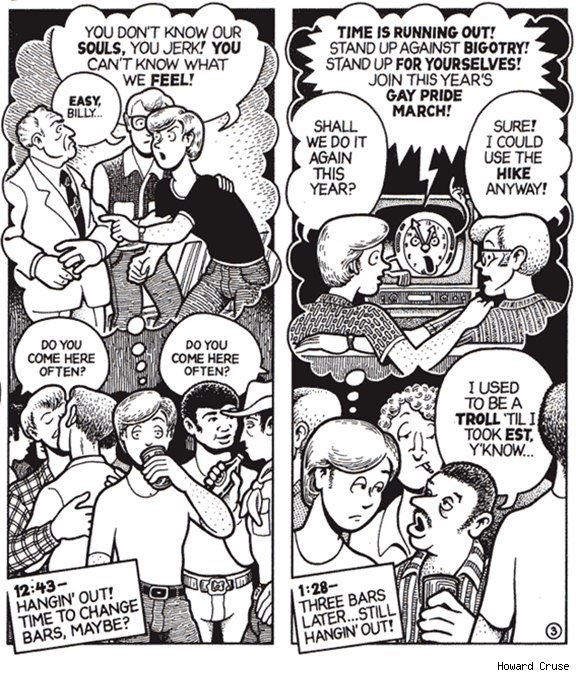
Billy Comes Out, by Howard Cruse
But I agree with you, I did not find that experience, what I found was material of remarkable complexity and thoughtfulness, and unfortunately some of the battles they were fighting back then we're still fighting now.
There's definitely a difference as you move through the four decades, but it's much more subtle than I expected. It's also a testament to how good those early creators were. Howard Cruse, Trina Robbins, Roberta Gregory, they're some of the best cartoonists in the business and they were doing work of surprising sophistication from the very beginning.
CA: Do you think the generation that is coming of age today - the new voices, the "It Gets Better" generation - will find the same resonance in those early comics?
I certainly hope so. One of the things that was very important to me was to give young queer readers and especially queer cartoonists a sense of their history and sense of their heritage. Queer history and culture is not something that is passed down within families, generally.
One of the most powerful moments in selling the book was at San Diego Comic-Con where we essentially debuted the book and it sold out, which was wonderful. The last book I sold was to a mother who came up to me – and I'm actually getting choked up about it – she came up to me and said she wanted to buy the book for her young gay son, he was 18, and she wanted him to see his culture. She couldn't tell him about what it meant to be a gay man, but this book could help him be proud of this culture and this community and this history. That was so incredibly powerful for me. I've heard from other young queers that they look at this book and get a sense of their heritage.
CA: That's really lovely to hear. Do you think that there's anything that the cartoonists of the previous generation can learn from these new voices in turn?
I think that some of these older cartoonists will hopefully be inspired by the limitless possibilities of the web and by the possibilities of the new kinds of storytelling in an era when queer stories can come in to the mainstream. Look at Alison Bechdel's career path, for example. She started in the queer media ghetto writing only for other queers, writing Dykes to Watch Out For which was only serialized in gay newspapers, but then she moved into the mainstream book market and became a New York Times bestseller with graphic novels that are very queer, but can now be accepted by everybody, can be read by everybody. I think those older cartoonist will be very much inspired by newer cartoonists finding their own voices and finding their own ways.
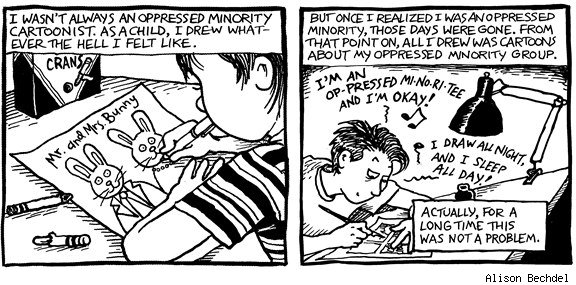
Oppressed Minority Cartoonist, by Alison Bechdel
CA: There is one strip from Alison Bechdel in the book about being an Oppressed Minority Cartoonist, which explores her frustration at having everything she does filtered through her sexuality and gender. The tension between queer identity and assimilation is a theme that recurs throughout the book. Do you think we're any closer to a synthesis of those two ideas?
That's one of the biggest questions that's constantly being grappled with. There's no answer to that question. Women cartoonists deal with it, queer cartoonists deal with it – do you call yourself a woman cartoonist or do you call yourself a cartoonist who happens to be a woman? The same thing with queer identities. It's a very tricky balancing act. It doesn't ever have one fixed answer and that's the end of it. It has to be constantly re-asked as society shifts and as your work shifts as a cartoonist.
I've struggled with that with my own work. When I first started making comics I did True Travel Tales, which was a series of biographical and autobiographical travel tales. I traveled around the world for years with a backpack and I made comics about it. And there were queer parts to that because I am queer and I would meet other queers, but for the most part it's not queer comics at all, and I had a wider audience within indie comics.
So there's a constant balancing act of how do you define your work and how do you find your audience. There are some people who very much want to speak to the queer audience and are perfectly content in doing that for their entire artistic career, and other people who do that for a while and then tackle other subjects, but who maybe want to bring in queer narrative concerns and points of view to their other work as well.
In the past if you had any queer characters at all in your comics, they were de facto queer comics, because the mainstream either ignored LGBT characters completely or abused them, essentially. So now we're in a position where society is much more accepting of LGBT communities and narratives, so you can have characters and themes in your comics without it being a queer comic, and that's exciting, that's liberating.
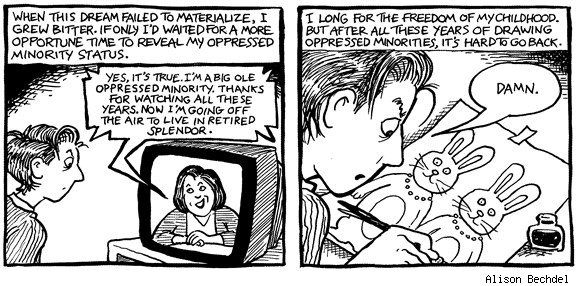
Oppressed Minority Cartoonist, by Alison Bechdel
My definition of queer comics is comics that speak to queer identities and realities from an insider's perspective. They don't have to be made by queer people, I have several straight creators in the book, like Trina Robbins and Joyce Farmer, but still have an insider's perspective. Now that the mainstream is more progressive, it's their job to incorporate and assimilate LGBT characters into their stories, but it remains the job of queer comics to dissect and analyze the queer experience in a more sophisticated way, to dig deeper. Clearly, some queer cartoonists will want to do this project, and others will not. The amazing thing is that in our culture now, there's a choice.
CA: I felt there was a shift as I moved through the book from biography and autobiography towards more allegorical stories and fiction, though all still clearly queer comics. Is that an accurate assessment of the evolution of queer comics?
I think that's probably true. I think there's a lot of science fiction and fantastical stories being done now. I'm seeing more of that on the web. There's still a lot of autobiography being done, however, and memoir will remain an important part of queer comics moving into the future because it's still so complicated, forming queer identities and accepting them and growing in to them is still such a complicated process that there will still be a lot of memoirs done around these themes.
You see this particularly with the trans creators. There was a smattering of trans stories happening earlier, but basically the trans cartoonists really came up in the beginning of the 2000s, so they're kind of in the position now of dealing with identity issues that gays and lesbians were dealing with back in the 70s and 80s, so it's interesting watching that happen.
Christine Smith, for example, is a web cartoonist who does a strip called The Princess about a trans girl and her family and friends. She was one of the recipients of the Queer Press Grant this year, in fact. She's basically creating a strip to help the little girl that she was when she was young, who never had any support. She's doing this for the new generation of trans children, creating role models, showing them images of themselves in a non-pathological way, and allowing them to be who they are.

The Princess, by Christine Smith
It's a similar project to Mary Wings', who was the first lesbian cartoonist. She had never heard the word lesbian until she was 19, so then she heard it and she was like, "oh, that's what I am," and then she made this comic about coming out as a lesbian and she tried to get it out there to help other young women in her position. I feel like her project was very similar to what Christine is doing now for trans girls, trans women, and that's an interesting generational parallel. Mary even said as much when I had both her and Christine on a panel at WonderCon.
CA: It seems to me there's more fluidity not just in terms of gender identity but also in terms of sexual identity in the later comics. There's a less monolithic, if I can say that, vision of what it means to be queer. Are we progressing towards a different understanding of queerness as we move through this book?
Absolutely. Concepts of queerness have changed dramatically across the years. You look at some of the early polemics around sexual identity, and a lot of the early folks didn't really believe in bisexuality, for example, or were very suspicious about gender fluidity, and now we're in a position where I think we can see queerness as a very complex spectrum that can involve both gender and sexuality.
And that complexity makes it even more fascinating as a subject to make comics about. So I'm excited about what happens next. I want to continue to see people like Edie Fake and Annie Murphy and Mysh, this cartoonist from Israel, doing really sophisticated interesting things about gender and sexual identity in ways that really were unimaginable earlier.
CA: I was interested reading Lana Wachowski's introduction to the book where she draws a contrast between the glamour and the perfection of superhero comics and this flawed, sweaty humanity of underground comics. Do you think this grungy carnality is an essential part of queer comics' identity?
It's hard to pigeonhole queer comics as an aesthetic or artistic style, and one of the purposes of the book is to show there is an incredibly wide range of artistic approaches to this material. That said, I would say a generally unifying factor of queer comics is a sort of rawness and honesty that oftentimes manifests as grittiness.
For me, I actually really like those stories. It's part of my bias as an editor, I like stories that are raw and honest and take your breath away with their intensity, I'm more drawn to stories that have that sort of aesthetic. To me there's something really exciting about an unfiltered vision, in all its quirkiness.
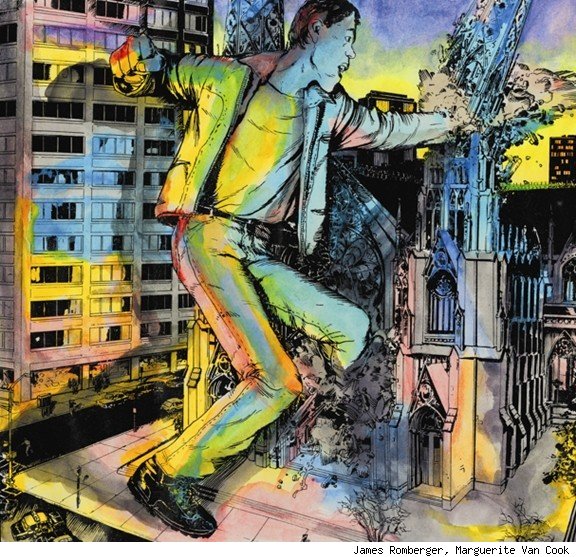
Seven Miles A Second, by David Wojnarowicz,
James Romberger & Marguerite Van Cook
One of the things that distinguishes comics is the do-it-yourself tradition, and it's ultimately about you and paper and ink, and you can get your vision, however eccentric and strange and unsalable it is, you can get it out with a photocopying machine and some ink on paper, and that makes it a medium that you don't need resources and money the way you do for film or for television or for other media. That makes comics a medium that's good at exploring strange eccentric views of identity, and that definitely translates to queer comics.
CA: Your collection starts around the time of the Stonewall Riots which are cited as the breakthrough moment for queer visibility. Was there anything pre-Stonewall, from a coded era of comics, that you were tempted to include?
Certainly you can get into semantics about what are comics – you can look at some Greek vases from antiquity and think of them as queer comics. But what we think of traditionally as comic books with queer material, it was really erotic comics that started it. Tom of Finland, I would say, was really the first gay cartoonist. He was doing these wordless sequential narratives with his character Kake, this jovial leather man who would get into very awkward situations.
This material was illegal. So really the depiction of gay erotica was a tremendous act of revolution, and was very dangerous. People were jailed, people were fined, businesses were taken down because of this material.
Those kinds of comics started in the 40s, 50s, 60s, and by the end of the 60s the obscenity laws were starting to be loosened, especially in the United States. … But it wasn't until the Stonewall Riots, which are generally thought of as the birthplace of modern gay culture, that suddenly gay newspapers and gay magazines started developing, and those publications needed comics, so that was when you saw the first gay gag strips appear.
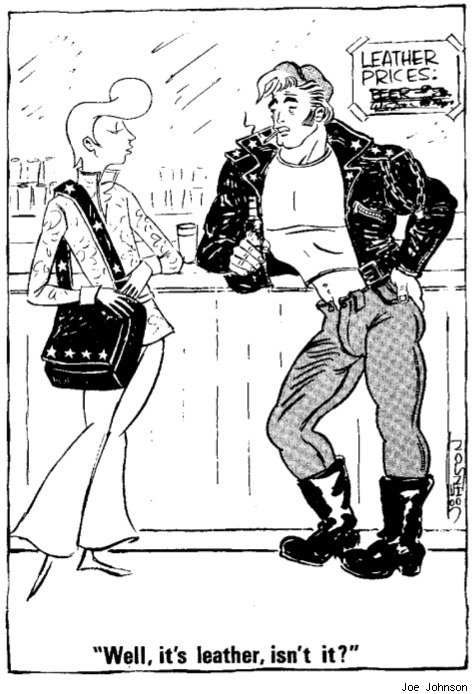
Miss Thing, by Joe Johnson
Oddly enough at the same time as this cultural awakening was happening in queer culture there was also the beginning of the underground comics movement happening in San Francisco. … So I think those two things kind of dovetailed. I think by the time that Gay Comix, the gay comics anthology that began in 1980, that Howard Cruse was able to bring in some of the sensibilities of the gay gag strips, the aspirations of the lesbian comics, and even some of the ribald nature of the gay erotica stuff that predated all of that, and really coalesce it into a broad anthology that showcased all of this material.
But it took a while. The early material was dangerous stuff to do. It's very hard for our generation to look back and imagine how difficult it was and how dangerous it was to produce queer material back then. We all owe a tremendous debt to the creators back then who risked so much in the name of artistic and personal freedom.
CA: Do you think LGBT comics are an area Fantagraphics may want to explore further? I don't want you to make a statement on their behalf, but I am curious. It seems Taschen has cornered the market on that part of the bookstore.
It will be interesting to see. One of the things I really wanted to prove to the American comics industry and to Fantagraphics is that a book like this could sell. Queer comics have a market. They can sell to straight readers who would be interested in queer narratives and compelling cartooning, but also a queer market still exists that is hungry for this material and will pay money for it. So the fact that it's doing so well is really gratifying, and I hope that it paves the way for more of this to happen from all sorts of publishers.
I would love to see some collections of some of the cartoonists, the European cartoonists, translations of some of their work, and maybe some of the earlier generation of American gay cartoonists. For example Jerry Mills who did the strip Poppers, that's an amazing comic, and he's dead, he died of AIDS unfortunately and is survived by his wonderful partner Sal, and his work is just fantastic. It's kind of a time capsule of gay realities and gay humor at the time, but it also still reads very fresh. It would be wonderful to have a good beautiful collection of his work. There's a lot of stuff like this that really should be collected.
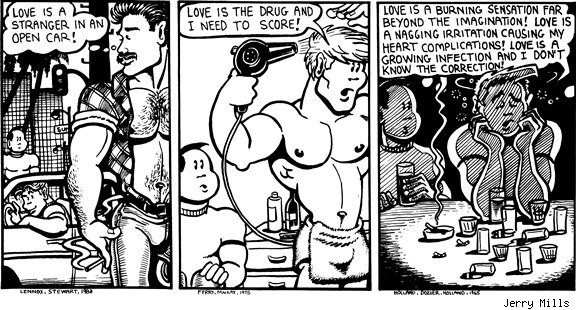
Poppers, by Jerry Mills
CA: Are there any creators who didn't make it into the book, any important queer voices coming up now that you think people should keep an eye out for the future?
One of the most difficult things in compiling the book was not being able to include some of the longer form webcomics, serialized comics, and graphic novels that are being done now. I wanted to stay away from unsatisfying excerpts, so most of this collection is complete short stories or one-pagers, but people should be on the look-out for more queer comics done on a larger scale, that are happening more and more.
I didn't include manga or Asian comics in the anthology because I feel like the world of queer manga is enormous, and has its own set of artistic intentions and cultural contexts behind it, and it really requires its own book. But what I'm seeing increasingly is this influence of queer Asian comics on queer American comics. Yaoi is such a huge genre – yaoi is stories of gay male sex and romance made by women for a primarily female audience – and you're seeing that aesthetic come over into queer American comics, as well as the aesthetic of bara, or gay male stories made by gay men for gay men, which have a different look to them.
CA: Do you think there may be a sequel to this collection?
I would love to revisit this in five or ten years and I think we'd see a different picture, I think we'll see a lot of young emerging cartoonists who are doing really exciting work, using all different kinds of influences, I think some of them will look back historically and be inspired by some of the older cartoonists as well, doing a lot of stuff on the web, doing a lot of long form comics, and that's going to be great. I'm really looking forward to seeing what happens. I would love to do a follow-up to this book ten years down the road.
Paul V.
Club and radio DJ; author, 'Born This Way' blog and book
Man, I am exhausted! It took all the energy I had to make a fabulous Halloween costume last week and make sure that Hurricane Sandy arrived to devastate the Eastern Seaboard. Apparently, gay people have special powers like that, at least according to the "Christian" pundits who blame every natural disaster on our very existence. Global warming be damned! Let's blame the gays!
But the truly exhausting part of living my life is fighting back against the lies and distortions that are still put forth about the LGBTQ community. Just when it seems like people are finally becoming more fair-minded, empathetic and in favor of our full equality, there's some knuckle-dragging homophobe waiting in the wings to rain on our parade. Come to think of it, that sure takes a lot of energy, too, living a life where you constantly have to bash and degrade other people. And for what? What do people like that get in return for their negativity?
And it all got me thinking about what kind of special powers the gay community actually does have, such as the immeasurable contributions we've made to the fabric of society and culture in every city, state, country and continent. As October was LGBT History Month, I was reminded of the multitudes of those contributions. And that was important for me to show in my book Born This Way: Real Stories of Growing Up Gay, as I want the gay kids of today to see a few of the people who've done just that and to give the future generations their own greatness to aspire to.
But for all those people who don't acknowledge us that way? Let's make a deal…
Slideshow @ hXXp://www.huffingtonpost.com/paul-v/still-homophobic-youre-going-to-have-to-give-up_b_2059510.html?utm_hp_ref=gay-voices
But I have not even scratched the surface here. There are thousands more examples in the world of sports, design, literature, acting, film, music, television, movies, science, art, architecture, theater and on and on and on. Now, granted, plenty of heterosexuals are/were involved in everything I cited here, and this is not to say that gay people are any better or more talented than straight people are. But the big difference is that straight people are not discriminated against solely based on their sexuality.
So the time has come for the LGBTQ community to finally say: It's all or nothing. You don't get to hate or demean gay people and vote against our equality – or worse, vote for politicians or a party who publicly state that we are not equal citizens -- and still enjoy all the things we bring that enrich your daily life experiences.
And if you want to remain homophobic, you do so at your own peril. Because be warned: We have calls out for a twister, a blizzard, an earthquake and a drought!
P.S. As a gift for you reading this, here's my 30-minute "Out 'N Proud Mix" that I made for National Coming Out Day, which features tons of your favorite LGBTQ artists and musicians.
Music Available @ hXXp://soundcloud.com/dj-paul-v/dj-paul-v-out-n-proud-mix
by Michael Kleinmann
The fact is, certain styles of underwear fit certain body types better than others. Whether they feel too big or too small, squeeze, sag or cause a constant wedgie, there is definitely an issue with men wearing the wrong style of underwear for their body type, and we’re setting out to fix that once and for all.
With so many unique fit options available today, settling for underwear that doesn’t look and feel 100% perfect is whack, so we’ve put together the definitive guide to choosing the right style of underwear for your body type. We can’t guarantee switching up your underwear style will make you look like David Beckham or anything, but if it feels better, that’s improvement we can all use.
Apple-shaped
Description: Short to average height with an overall rounded shape.
Underwear Issues: Digging waistbands that cause muffin top and uncomfortable pinching, tight leg bands, and general discomfort due to a too-snug fit.
We recommend: Boxer shorts. The relaxed fit leaves plenty of room for movement and comfort. Try the Polo Ralph Lauren Modal Button-Fly Boxer–the silky soft modal fabric is nice and lightweight to prevent that bulky feeling boxer shorts can tend to have. If you must have a more form-fitting style, try a boxer brief with a soft elastic waistband and without banded leg trim, like the Calvin Klein Underwear Flexible Fit Boxer Brief.
Pear-shaped
Description: Your upper body is disproportionately slimmer than your lower body, resulting in a thicker waistline, wide thighs and ample butt.
Underwear Issues: The extra junk in your trunks finds you in need of more coverage, a loose or gaping waistband and leg bands that ride up.
We recommend: Your best bet is full coverage, like trunks and boxer briefs. The mid-waist rise and longer leg length will provide a full-coverage look that evens out your shape for a more flattering profile. Try a style with color or a pattern to really pep up your look, like the Diesel Fresh and Bright Divine Trunk. Boxer briefs are especially great because the length can reduce thigh chafing, just make sure you choose a style without thick leg trim, such as the Calvin Klein Underwear X Cotton Modal Boxer Brief. Avoid styles with a low-rise, as they will automatically fall beneath the coverage level you need, as well as any form of high cut or bikini style briefs.
Slim
Description: Also called “skinny” or “slender,” your frame is thin and there is not much meat on your bones.
Underwear Issues: Clothes and underwear tend to always appear a little big, and certain types of underwear, most notably skimpy briefs, may emphasize your thin thighs and itty bitty waistline.
We recommend: Trunks are great for thin frames because the legs extend to the tops of your thighs and give the flattering illusion of a little more meat on your bones, as well as boosting your butt a bit. Try a low-rise trunk like the C-IN2 Prime Lo No Show Army Trunk, which features a pop of color and a wide logo waistband that makes your abs look great. You could do briefs, but consider that the skimpier you go, the skinnier you’ll look. Try a brief with a more classic fit, like the Michael Kors Free Fit Brief.
Short
Description: Your height happens to fall beneath the 5’8″ mark (that’s 173cm for you Europeans).
Underwear Issues: You find most styles offer too much coverage, causing the waistband to rise above your actual waist and which may result in some sagging in the back.
We recommend: A variety of traditional cuts like briefs and trunks are available in low-rise versions that simply offer a leaner, trimmer fit than their regular fitting counterparts. The low-rise may not be that low on your body type, but they won’t rise above your belly button, successfully averting the diaper look. Two of our favorites include the Emporio Armani Stretch Cotton Brief, which is always available in a slew of bright colors each season, as well as the 2(X)IST Colour Range No-Show Trunk, which comes in both solid colors as well as striped varieties.
Tall
Description: That’s you, guys 6’2″ (188cm) and above, famous for a long torso and legs for days that can make underwear fit a lot smaller than it actually is.
Underwear Issues: Most customary styles simply don’t give you enough coverage–briefs tend to ride up in the back legs, the back of the waistband droops, exposing plumber’s crack, and even some trunks just look like they’re to small.
We recommend: First off, avoid any type of low-rise style–even full coverage styles with a low-rise will feel like you need to pull them up more. Your best bet is full coverage and long length, giving you access to a variety of boxer brief and trunk styles, like the Hugo Boss Performance Comfort Stretch Cotton Boxer Brief.
Calvin Klein Underwear also offers the Tall Man Boxer Brief, which looks exactly like their classic boxer brief, but is designed especially for bodies with longer physiques.
Taken from : 
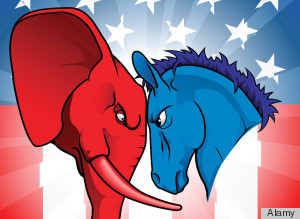
By: Trudy Ring
11.4.2012
Via The Advocate
LGBT voters, who could make the difference in the close presidential race, support President Obama in even greater numbers than they did earlier this year, according to a new poll.
The Harris Interactive poll, conducted for the Logo TV network late last month, found that after the last presidential debate, 72% of likely LGBT voters favored the president, up from 65% in the previous Harris/Logo survey in August. Support for Mitt Romney declined slightly, from 21% to 20%.
“The movement toward Obama is mostly a shift of LGBT voters who were unsure on the initial vote in August (9%) who have now moved to Obama,” the Harris report says. “If Election Day is as narrow as many are predicting, Romney’s inability to turn these unsure LGBT voters to his candidacy could mean the difference between victory and defeat.”
Among the general population, support for Obama slipped somewhat since August, when Harris found 44% favored him and 39% backed Romney. The more recent numbers were 41% for Obama and 43% for Romney.
The increase in LGBT support for Obama was not primarily due to LGBT issues, as respondents already felt positively about his support for these causes, Harris reports. Instead, there was a surge in the number of LGBT voters who believed he would handle economic matters better than Romney and those who felt he “cares about people like me.”
Monday night, celebrities and pundits will discuss the poll results on the Logo special NewNowNext Vote, hosted by Wanda Sykes, with guests including RuPaul, Al Sharpton, Chely Wright, Dean Obeidallah, S.E. Cupp, Judy Gold, and Thomas Roberts. It will air at 10:30 p.m. Eastern.
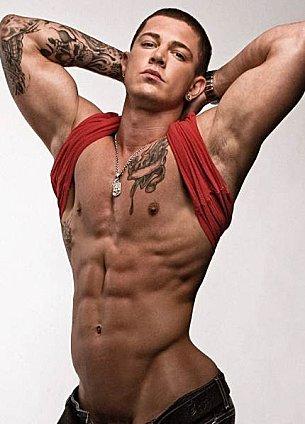
By: Daniel Villarreal
11.3.2012
This last weekend gay porn star Sebastian Young got arrested in Volusia County, Florida on two alleged charges of battery against his wife.
According to The Sword, this is Young's tenth arrest in Florida. His other included charges of robbery, reckless driving, false imprisonment, parole violation, trafficking stolen property and "battery upon a person 65 years or older."
Wow. Was grandma being stingy with the snickerdoodles?
His latest charge, "aggrevated battery," implies violence either against a pregnant woman, with a deadly weapon and/or with intentional infliction of great bodily harm, permanent disability or disfigurement.
Ten arrests! Twelve mugshots (below)! That's one angry, messed-up man right there. Looking at his rapsheet, some psychiatric medication and drug rehab may be in order. There's no word yet on the status of his wife, but hopefully she and her hypothetical baby are okay. Stay away from those crazies , girl. They're bad news.
Whenever the authorities let Young out of jail, he and recently convicted gay-for-pay pornstar Ryan Idol can hope for a scene in Chi Chi LaRue's Criminal Cocks.
